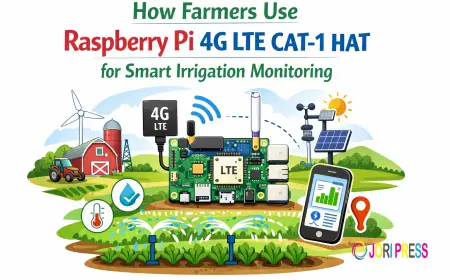India Artificial Intelligence Market 2031: Size, Forecast, and Leading Players Analysis
According to TechSci Research report, “AIoT Platform Market - Global Industry Size, Share, Trends, Competition Forecast & Opportunities, 2030F, The Global AIoT Platform Market was valued at USD 5.89 billion in 2024 and is expected to reach USD 32.29 billion by 2030 with a CAGR of 32.79% through 2030.
This journey is not merely growth in numbers—it marks a shift in how we perceive connected systems, data intelligence, and automation. AIoT platforms are reshaping industries, empowering connected vehicles, optimizing manufacturing lines, elevating retail experiences, safeguarding financial systems, and enhancing public infrastructure. Their strategic role is redefining business models and laying the groundwork for intelligent ecosystems everywhere.
Request For Sample Copy of Report For More Detailed Market insight: https://www.techsciresearch.com/sample-report.aspx?cid=29433#requestform
Industry Key Highlights
-
Primary Growth Drivers: Autonomous vehicles, vertical-focused AIoT, 5G-enabled edge analytics
-
Fastest Growing Vertical: Banking, Financial Services & Insurance (BFSI)
-
Regional Leader: Asia-Pacific (China, India, Japan, South Korea)
-
Core Trends: AI at the edge, domain-centric platforms, large-scale connectivity
-
Key Players: IBM, Microsoft, Google, Cisco, Siemens, Huawei, Intel, SAP
Browse over XX market data Figures spread through XX Pages and an in-depth TOC on the "Global AIoT Platform Market"@https://www.techsciresearch.com/report/aiot-platform-market/29433.html
The Pivotal Role of Autonomous Vehicles & Connected Transportation
One of the most compelling drivers of AIoT platform adoption globally is the rise of autonomous vehicles and connected transportation systems. Roads are no longer mere conduits—they’ve become dynamic data streams powered by millions of sensors, cameras, and intelligent systems. AIoT platforms transform raw sensor data into real-time insights, enabling:
-
Advanced Driver Assistance Systems (ADAS): lane assist, pedestrian detection, predictive braking
-
Vehicle-to-Everything (V2X) Communication: seamless dialogs between vehicles, infrastructure, and city services
-
Autonomous Vehicular Decision-Making: path planning, adaptive cruise control, environment mapping
Simultaneously, smart traffic systems deploy AIoT platforms to dynamically regulate signal timing, interpret road conditions, and divert flows based on real-time congestion data—reducing travel time, carbon emissions, and accidents. Governments and logistics operators worldwide are investing heavily in this sector, recognizing its integral role in defining future mobility.
Custom-Tailored AIoT for Industry Verticals
While early AIoT systems were broadly generalized, a significant transformation now lies in industry-specific platform design. Generic solutions cannot address the nuances of each sector’s data, compliance needs, or operational idiosyncrasies. Consequently, vendors are deploying AIoT platforms tailored to verticals such as:
-
Healthcare: Remote patient monitoring, personalized medical dashboards, asset tracking
-
Agriculture: Predictive crop analytics, precision fertilization, livestock health monitoring
-
Energy & Utilities: Smart grids, leak detection, consumption analytics
-
Transportation & Logistics: Fleet optimization, warehouse automation, real-time tracking
-
Retail: Customer behavior analysis, inventory intelligence, in-store personalization
-
Manufacturing: Predictive maintenance, robotics coordination, quality assurance
By adapting algorithms, device integrations, and interface design to industry-specific workflows, these platforms improve implementation speed, reduce complexity, and deliver measurable ROI—transforming AIoT from a novelty to a necessity.
BFSI: The Fastest-Growing Vertical
The Banking, Financial Services, and Insurance (BFSI) sector has the highest adoption rate of AIoT platforms. The synergy of AI and IoT allows financial institutions to:
-
Strengthen Security: Monitoring ATMs, vaults, inputs, network traffic with AI-based threat detection
-
Prevent Fraud: Real-time anomaly recognition across devices, locations, and timeframes
-
Enhance Customer Experience: Personalized advice via smart teller systems; AI chatbots at ATM lobbies; remote biometric verification
-
Streamline Operations: Automating queueing, identifying maintenance needs, monitoring network infrastructure
Additionally, BFSI entities are exploring smart insurance programs and automated credit scoring, supported by IoT customer data and AI predictive models—making BFSI the leading growth engine for AIoT platforms.
Asia-Pacific: The Fastest-Growing Region
The Asia-Pacific region is fast emerging as the fastest-growing AIoT platform market, driven by:
-
Rapid Industrialization: Manufacturing and smart city investments in China, India, and South Korea
-
Digital Infrastructure: Experiments in 5G rollouts, large-scale smart grid projects
-
Strategic Government Policies: National digital programs and infrastructure modernization initiatives
-
Collaborative Ecosystem Development: Hawaii of startups, academia, global–local tech partnerships
-
Edge & 5G Synergy: Support for real-time decision-making and low-latency AIoT applications
These conditions make APAC the fulcrum of global AIoT adoption in the years ahead.
Emerging Trends in AIoT Platforms
1. Filtered Intelligence with Edge AI
Edge computing within AIoT is gaining traction as smart devices process data locally—crucial for autonomous systems, medical monitoring, industrial controls, and latency-sensitive applications. This architecture reduces bandwidth, increases privacy, and ensures resilient decision-making.
2. Vertical-Specific Platform Differentiation
AIoT vendors now offer platforms designed specifically for individual industries—customizing feature sets, integration patterns, and analytics to vertical workflows, user interfaces, and compliance regimes.
3. Mesh Architecture & Distributed Intelligence
Systems are embracing edge nodes, gateways, and cloud orchestration—forming intelligent mesh networks where data processing is distributed across tiers to optimize speed, reliability, and cost.
4. Hyper-Automation Through AIoT
From autonomous fleets to robotic warehouses and smart grids, AIoT platforms are foundational to end-to-end automation—with ecosystem interfaces spanning ERP, CRM, supply chain, and field services.
5. Secure AI/IoT Data Pipelines
As systems scale, so does their data visibility. Secure pipelines built with encryption, anomaly detection, behavior analytics, and zero-trust access are no longer optional—they are mandatory.
Core Drivers Powering AIoT Growth
-
Scalable Autonomous Systems: From connected vehicles to drones and robotics, AIoT is foundational
-
Demand for Real-Time Intelligence: Latency-sensitive applications demand on-device insights
-
Cost & Efficiency Pressures: Predictive diagnostics reduce downtime, optimize assets
-
Global 5G Deployment: Low-latency networks accelerate edge AI capabilities
-
Regulatory Compliance & Traceability: Smart systems ensure process integrity and data logs
-
Tech Ecosystem Maturity: AI frameworks like TensorFlow and IoT standards like MQTT are now ubiquitous
-
Digital Economy Initiatives: Smart city programs, energy digitization, agriculture upgrades incentivize AIoT
-
Finance Vertical Ambition: BFSI-led adoption is unlocking broader enterprise interest
Competitive Analysis
The AIoT platform market is increasingly strategic, with both tech giants and specialized players:
Core Competitors
-
IBM Corporation: Watson IoT on Cloud Pak; deep enterprise AI integration
-
Microsoft Corporation: Azure IoT Hub + Cognitive Services—edge-to-cloud agnostic solutions
-
Google LLC: AI-first analytics, edge compute with TensorFlow Lite and Cloud IoT Core
-
Cisco Systems: Secure networking, edge orchestration with Kinetic
-
Siemens AG: MindSphere for industrial IoT with AI analytics
-
Huawei Technologies: Atlas edge AI systems, digital twin integration
-
Intel Corporation: Edge/IOT chip platforms + OpenVINO for neural acceleration
-
SAP SE: ERP-integrated AIoT with Industry 4.0 and enterprise workflows
Differentiation Strategies
-
Vertically Deployed Solutions: Siemens, SAP, and IBM focus on manufacturing, energy, healthcare
-
Edge-AI Hardware Partnerships: Intel and Huawei offer optimization-focused toolkits
-
Enterprise-Grade Networking: Cisco combines secure networking with integrated AI frameworks; Azure and AWS offer hybrid device connectivity with multilingual analytics capabilities.
Strategic Positioning
A significant element of competitive advantage lies in open platforms supporting:
-
Run-on-premise, edge, or hybrid
-
Plug-and-play vertical modules
-
Ethical data governance
-
Developer ecosystems with pre-trained models
-
Governmental compliance and IoT licensing
Customers can also request for 10% free customization on this report.
Top 10 Benefits of the Research Report
-
Growth Forecasting
-
Five- and six-year projections support strategic planning
-
-
Segmented Breakdown
-
Market insights by service, solution, vertical, region
-
-
Competitive Mapping
-
Key players, SWOT assessment, capability comparison
-
-
Trend Identification
-
Edge AI adoption, autonomous mobility, sector-specific dynamics
-
-
Innovation Guidance
-
Discover blueprints for pilots and full-scale implementations
-
-
Ecosystem Deep-dive
-
Insights into government policies, 5G rollouts, R&D incentives
-
-
Tech Stack Details
-
Analysis on edge frameworks, neural architectures, data pipelines
-
-
Risk & Compliance
-
Cyberthreat mitigation, regulatory adherence, scalability risks
-
-
Strategic Toolkit
-
Roadmaps, scorecards, risk matrices, stakeholder models
-
-
Custom Reporting
-
Tailorable sections for specific verticals, regions, or use cases
Contact US:
Techsci Research LLC
420 Lexington Avenue, Suite 300,
New York, United States- 10170
Tel: +13322586602
What's Your Reaction?
 Like
0
Like
0
 Dislike
0
Dislike
0
 Love
0
Love
0
 Funny
0
Funny
0
 Angry
0
Angry
0
 Sad
0
Sad
0
 Wow
0
Wow
0

















































